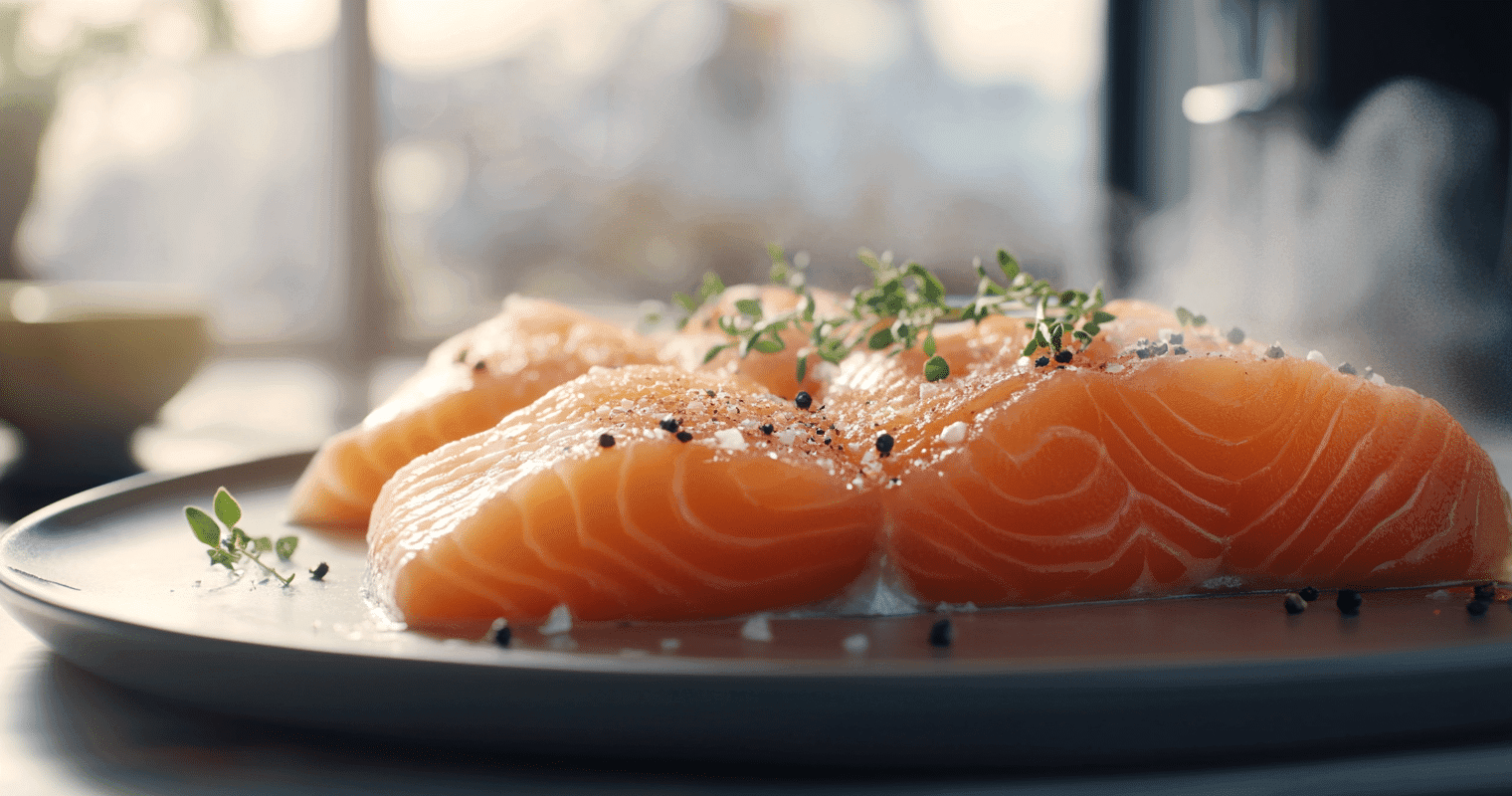Jump to:
Estimated reading time: 9 minutes
Table of contents
Introduction: Why Smoked Salmon Expensive
People around the world enjoy smoked salmon for its rich, savory flavor and delicate texture, making it a renowned delicacy. It’s a staple on gourmet menus and frequently graces everything from brunch spreads to fine dining plates. However, many consumers continue to wonder why is smoked salmon so expensive? This question arises not only from its hefty price tag but also from growing awareness of how food is sourced, processed, and priced.
While smoked salmon offers exceptional flavor, nutrition, and versatility, these qualities come with a premium cost. The production of smoked salmon, particularly high-quality varieties, involves intricate processes that require significant time, labor, and resources. From the sourcing of wild or farmed salmon to the careful curing and smoking process, each step adds to the final cost of this luxury food item. Factors like sustainability, handling, transportation, and packaging all further increase the price. Moreover, its strong association with luxury and fine dining creates an aura of exclusivity, which contributes to its high market value.
In this article, we’ll explore the various reasons why smoked salmon is expensive and provide a deeper understanding of the production, sourcing, and market dynamics that contribute to its high price. By the end, you’ll understand what makes this delicious treat worth the cost.
Why Smoked Salmon Expensive: The Fishing and Sourcing Process
1. Sourcing Wild vs. Farmed Salmon
One of the primary reasons why smoked salmon is expensive lies in the sourcing process. Smoking primarily uses two types of salmon: wild-caught and farmed. Both come with distinct challenges that contribute to the overall cost.
Wild-Caught Salmon
People consider wild-caught salmon the gold standard for quality and flavor. Fishermen catch these fish in their natural habitats, such as rivers and oceans, where they feed on a natural diet and develop the rich, deep flavor many consumers prefer. However, sourcing wild salmon comes with significant costs, including:
- Limited Availability: Wild salmon is only available during certain fishing seasons, limiting supply and increasing demand.
- Labor-Intensive: Fishing for wild salmon requires more labor and effort compared to farmed salmon, which pushes up the price.
- Sustainability Concerns: Strict regulations are in place to prevent overfishing, further limiting the supply of wild salmon and driving up costs. Learn more about the true cost of sourcing salmon from National Geographic.
Farmed Salmon
Farmed salmon, while more readily available year-round, also contributes to why smoked salmon is expensive. Although it’s typically cheaper than wild salmon, the farming process still comes with costs related to maintaining fish farms, feeding the salmon, and adhering to environmental regulations.
- Farm Management: Fish farms must invest in proper infrastructure, water quality management, and disease prevention, all of which add to the production costs.
- Feed Costs: Farmers use specially designed feed to ensure farmed salmon grow healthily, and this specialized feed raises the overall production cost.
Whether you’re buying wild-caught or farmed varieties, the sourcing process plays a major role in why smoked salmon is expensive. You can explore more about sustainable fishing practices at Marine Stewardship Council.
Why Smoked Salmon Expensive: The Labor-Intensive Smoking Process
2. Traditional Smoking Methods
The labor-intensive process of smoking salmon is another major factor in why smoked salmon is expensive. Preparing smoked salmon requires time, skill, and precision, as you must cure, dry, and smoke the fish to perfection. Traditional smoking methods, passed down through generations, add authenticity and flavor to the final product, but they also raise the cost.
Curing the Salmon
Before smoking, you must first cure the salmon using a mixture of salt and sometimes sugar. The curing process draws out moisture from the fish and helps preserve it. Depending on the desired outcome, this process can take anywhere from several hours to a full day.
- Time-Consuming: The curing stage requires patience and precision. You must monitor the salmon closely to ensure it doesn’t become over-cured, as this could ruin its flavor and texture..
- Quality Control: Skilled workers inspect and prepare each fish for smoking, ensuring they maintain the highest quality standards.
Smoking the Salmon
Once you cure the salmon, it moves to the smoking stage. Depending on whether it’s cold-smoked or hot-smoked, you expose the fish to smoke from hardwoods like alder, hickory, or oak for several hours. This adds the characteristic smoky flavor and preserves the fish. Learn more about how smoking methods affect flavor at The Spruce Eats.
- Cold Smoking: Cold smoking takes place at lower temperatures (under 90°F or 32°C) and can last for 12-48 hours. This method demands a more hands-on approach and careful monitoring since the fish isn’t fully cooked.
- Hot Smoking: Hot smoking occurs at higher temperatures (120-180°F or 49-82°C) and fully cooks the fish in the process. While faster than cold smoking, it still requires skill to prevent overcooking.
The time, effort, and specialized equipment involved in the smoking process explain why smoked salmon is expensive.
Why Smoked Salmon Expensive: Handling and Transportation Costs
3. Refrigeration and Packaging
Smoked salmon is a perishable product, and ensuring it remains fresh throughout the supply chain is another reason why smoked salmon is expensive. Proper handling, refrigeration, and packaging play a critical role in maintaining the quality and safety of smoked salmon, especially during transport from processing facilities to retailers.
Temperature Control
You must keep smoked salmon at a controlled temperature throughout its journey from the production facility to the store. This requires refrigeration during transportation and storage, which adds to the cost.
- Cold Chain Logistics: Cold chain logistics keep smoked salmon fresh at all times, preventing spoilage and maintaining quality. The additional infrastructure required for temperature control drives up the price of the final product.
Specialized Packaging
Producers often use specialized vacuum-sealed packaging to keep smoked salmon fresh. This packaging not only preserves the fish’s flavor and texture but also extends its shelf life. While necessary, this type of packaging adds another layer of cost, contributing to why smoked salmon is expensive.
- High-Quality Materials: Packaging for smoked salmon must meet certain standards to ensure the product remains safe to eat. Vacuum-sealed bags or airtight containers help preserve freshness, but they also come at a higher cost compared to regular packaging.
Why Smoked Salmon Expensive: Supply and Demand Dynamics
4. High Market Demand
One of the key reasons why smoked salmon is expensive is simple: high demand. Many people love smoked salmon for its luxurious taste and versatility, making it a popular choice for special occasions, fine dining, and everyday meals. High-quality smoked salmon is in limited supply, especially wild-caught varieties, which aren’t available year-round.
Popularity Among Consumers
Smoked salmon’s widespread appeal plays a significant role in why smoked salmon is expensive. From high-end restaurants to home kitchens, smoked salmon is in constant demand for use in appetizers, breakfasts, salads, and gourmet dishes. This high demand leads to increased prices as producers strive to meet consumer needs without compromising on quality.
- Premium Product: Consumers view smoked salmon as a premium product, making it a frequent feature in fine dining establishments and catering events. The perceived luxury and status associated with smoked salmon push the price higher. Learn more about the market dynamics in this BBC article.
Supply Chain Limitations
Limited supply, particularly for wild-caught salmon, is another reason why smoked salmon is expensive. The seasonal nature of wild salmon fishing, coupled with strict sustainability regulations, limits the availability of this prized fish, driving up its market price.
Why Smoked Salmon Expensive: Sustainability and Environmental Concerns
5. Sustainable Fishing Practices
In recent years, environmental sustainability has become an increasingly important factor in the seafood industry. This emphasis on responsible sourcing practices plays a major role in why smoked salmon is expensive, especially for wild-caught varieties.
Protecting Wild Salmon Populations
Strict regulations are in place to protect wild salmon populations from overfishing. These regulations ensure wild salmon populations stay healthy and sustainable for future generations, but they also limit how much salmon fishermen can harvest, which drives up the price.
- Sustainability Certifications: Smoked salmon that carries certifications such as the Marine Stewardship Council (MSC) label guarantees that the fish was sourced responsibly. These certifications reassure consumers but also come at a cost, as compliance with sustainable fishing practices requires investment.
Farmed Salmon Sustainability
Farmed salmon, while more readily available, also faces sustainability challenges. Efforts to reduce the environmental impact of fish farming, including reducing pollution and improving feed efficiency, contribute to why smoked salmon is expensive.
Frequently Asked Questions (FAQ)
1. Why is smoked salmon more expensive than fresh salmon?
Smoked salmon is more expensive than fresh salmon due to the additional labor, time, and resources involved in the curing and smoking process. The sourcing of high-quality salmon, whether wild-caught or farmed, and the labor-intensive smoking methods drive up the costs. Fresh salmon doesn’t undergo the same complex preparation, making it cheaper in comparison.
2. Is wild-caught smoked salmon more expensive than farmed smoked salmon?
Yes, wild-caught smoked salmon is generally more expensive than farmed salmon. Wild-caught salmon is only available during certain seasons, which limits supply and raises demand. Additionally, fishing for wild salmon is more labor-intensive, and sustainable fishing practices further limit the harvest, which adds to the cost.
3. Why is cold-smoked salmon more expensive than hot-smoked salmon?
Cold-smoked salmon is often more expensive because it requires a more delicate and time-consuming smoking process. Cold smoking occurs at lower temperatures and for longer periods (up to 48 hours), making it labor-intensive and requiring careful monitoring. Hot-smoked salmon, on the other hand, is fully cooked at higher temperatures, which is a faster and less complex process.
4. How does sustainability impact the price of smoked salmon?
Sustainability plays a significant role in why smoked salmon is expensive. Sustainable fishing practices, such as those that protect wild salmon populations, limit the amount of salmon that can be harvested each year. Additionally, fish farms must adopt eco-friendly practices, which increase production costs. These sustainability efforts raise the overall price of smoked salmon but ensure the long-term health of salmon populations and the environment.
Conclusion: Why Smoked Salmon Expensive?
In conclusion, several factors explain why smoked salmon is expensive. From the sourcing of wild or farmed salmon to the labor-intensive curing and smoking process, every step involves significant costs that contribute to the final price. Handling, packaging, and transportation all add to the cost, especially with the need for refrigeration to keep the product fresh. High market demand and limited supply—particularly for wild-caught varieties—also play a major role in driving up prices.
Sustainability efforts to protect wild salmon populations and implement eco-friendly practices in fish farming come at an additional cost, but they ensure that smoked salmon remains available for future generations. Quality control, premium ingredients, and the skilled labor involved in producing smoked salmon further contribute to its high price tag. Lastly, the perception of smoked salmon as a luxurious, gourmet item solidifies its position as a premium product that commands higher prices in the market.
Now that you understand the various factors behind why smoked salmon is expensive, you can appreciate the craftsmanship, effort, and resources that go into producing this beloved delicacy. While the price may be high, the unique flavor, nutritional benefits, and luxury status of smoked salmon make it a worthwhile indulgence for many. Whether you’re enjoying it at a fine dining restaurant or adding it to your home-cooked dishes, smoked salmon remains a delicious and special treat worth savoring. For more ways to enjoy this delicacy, explore Smoked Salmon Best Pairings.






